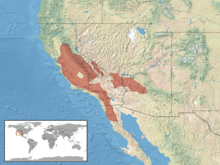Plestiodon gilberti
| Gilbert's skink | |
|---|---|
 | |
| Not evaluated (IUCN 3.1) | |
| Scientific classification | |
| Kingdom: | Animalia |
| Phylum: | Chordata |
| Subphylum: | Vertebrata |
| Class: | Reptilia |
| Order: | Squamata |
| Suborder: | Lacertilia |
| Infraorder: | Scincomorpha |
| Family: | Scincidae |
| Genus: | Plestiodon |
| Species: | P. gilberti |
| Binomial name | |
| Plestiodon gilberti (Van Denburgh, 1896) | |
 | |
| Synonyms | |
| |
Plestiodon gilberti, Gilbert's skink, is a species of heavy-bodied medium-sized lizard of the family of skinks. It is endemic to the southwestern United States, and grows to about 7 to 12 cm (3 to 4.5 in) in total length.
Taxonomy
Plestiodon gilberti was first described by Van Denburgh in 1896. It was named in honor of Van Denburgh's teacher, American ichthyologist Dr. Charles H. Gilbert (1859 - 1928), who at the time was a professor of zoology at Stanford University.[2]
There are five subspecies of Plestiodon gilberti:
- Arizona skink, P. g. arizonensis (Lowe and Shannon, 1954)
- Greater brown skink, P. g. gilberti (Van Denburgh, 1896)
- Northern brown skink, P. g. placerensis (Rodgers, 1944)
- Variegated skink, P. g. cancellosus (Rodgers and Fitch, 1947)
- Western red-tailed skink, P. g. rubricaudatus (Taylor, 1935)
(P. g. placerensis got its name from Placer County, California, where it occurs.)
Together with the western skink (P. skiltonianus), the San Lucan skink (P. lagunensis), and the four-lined Asiatic skink (P. quadrilineatus), Gilbert's skink belongs to the so-called "skiltonianus group". The exact taxonomy within this group is being questioned and may need revision following DNA analysis research.
Geographic range
Gilbert's skink occurs mainly in California. It is found in the northern San Joaquin Valley, in the foothills of the Sierra Nevada from Butte County southward, and along the inner flanks of the Coast Ranges from San Francisco Bay to the Mexican border and into northern Baja California. It is also found in the mountains of southern California, and at scattered mountain localities in the eastern desert from Mono County to San Bernardino County. Isolated populations also occur in western Arizona as well as in southern Nevada.
Habitat
Gilbert's skink occurs in habitats ranging from sea level to elevations of about 2,200 m (7,200 ft). Found in a wide variety of habitats, this lizard is commonest in early successional stages or open areas within habitats in which it occurs, which range from grassland to open chaparral or open pine forests. Heavy brush and densely forested areas are generally avoided.
Description

Gilbert's skink is a heavy-bodied lizard with small legs. Adults are uniformly colored in green, grey, olive or brown. Juveniles have light stripes on the sides and the back enclosing a broad black or brown stripe. This dark stripe stops near base of a waxy-pink tail. The striping fades with growth and maturation.
Behavior
This robust skink is seldom seen in the open. It forages through leaf litter and dense vegetation, occasionally digging through loose soil. It is a good burrower and often constructs its own shelter by burrowing under surface objects such as rocks or rotting logs. Females construct nest chambers in loose moist soil several centimeters deep, especially under flat stones.
Reproduction
The reproductive season for this species varies geographically and from year to year depending on local conditions. Little is known about the timing of reproduction, but it is probably similar to the Western Skink. Clutch size varies from 3 to 9 eggs.
See also
- Broad-headed skink - similar morphology
References
Further reading
- Behler, J.L., and F.W. King. 1979. The Audubon Society Field Guide to North American Reptiles and Amphibians. Knopf. New York. 743 pp. ISBN 0-394-50824-6. (Eumeces gilberti, pp. 571–572 + Plates 430, 434.)
- Smith, H.M., and E.D. Brodie, Jr. 1982. Reptiles of North America: A Guide to Field Identification. Golden Press. New York. 240 pp. ISBN 0-307-13666-3. (Eumeces gilberti, pp. 78–79.)
- Stebbins, R.C. 2003. A Field Guide to Western Reptiles and Amphibians, Third Edition. The Peterson Field Guide Series ®. Houghton Mifflin. Boston and New York. xiii + 533 pp. ISBN 0-395-98272-3. (Eumeces gilberti, pp. 314–315 + Plate 36 + Map 108.)
- Vandenburgh, J. 1896. Description of a New Lizard (Eumeces gilberti) from the Sierra Nevada of California. Proc. California Acad. Sci., Second Series 6: 350-352.
External links
| Wikispecies has information related to: Plestiodon gilberti |
- Gilbert's Skink at the U.S. Geological Survey.
- Gilbert's Skink at the California Department of Fish and Game.
- Plestiodon gilberti at the Encyclopedia of Life